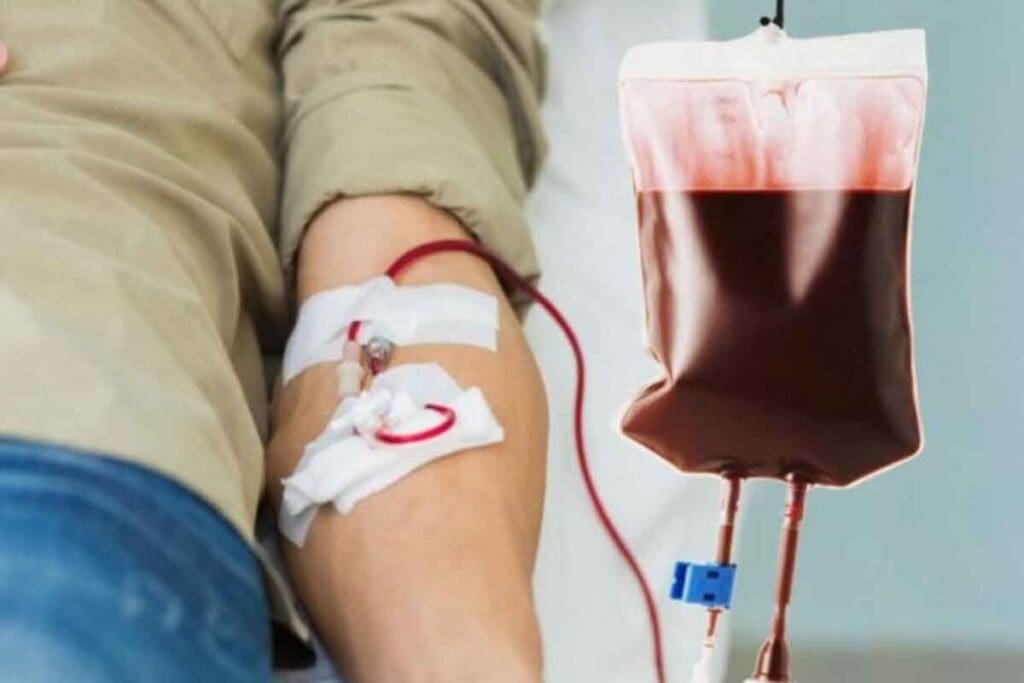Last Updated on November 20, 2025 by Ugurkan Demir

At Liv Hospital, we know how important it is to spot acute blood loss anemia quickly. This condition happens when blood loss drops hemoglobin and hematocrit levels too low. It’s seen in men with levels below 13.5 g/dL and in women with levels below 12.0 g/dL after a big blood loss or injury.
Anemia means not enough red blood cells, hemoglobin, or packed red blood cells in the blood. We focus on the causes of severe anemia and how to diagnose it. This is key to helping patients.
We aim to give fast and effective care for anemia emergencies. Knowing the acute blood loss anemia criteria helps doctors act quickly. This can save lives.

Acute blood loss anemia happens when red blood cells drop quickly, often from bleeding. Symptoms include pale skin, a fast heart rate, low blood pressure, and not enough blood volume. In severe cases, it can lead to anemia and shock.
Acute blood loss anemia occurs when red blood cells are lost suddenly, usually from bleeding. This can be from outside injuries or internal bleeding, like in the stomach.
The body tries to make up for lost blood by changing how it works. This includes trying to keep blood pressure up and ensuring tissues get enough oxygen.
Key Pathophysiological Changes:
It’s important to know the difference between acute and chronic anemia. They have different causes and treatments.
| Characteristic | Acute Anemia | Chronic Anemia |
| Onset | Sudden | Gradual |
| Common Causes | Hemorrhage, trauma | Chronic disease, nutritional deficiencies |
| Symptoms | Sudden pallor, tachycardia, hypotension | Gradual fatigue, weakness, pallor |
| Management | Immediate resuscitation, addressing the cause | Treatment of the underlying cause, supportive care |
This distinction is key to making the right decisions in treatment and improving patient care.
In summary, understanding acute blood loss anemia means knowing its definition, how it works, and how it’s different from chronic anemia. Knowing these details is essential for quick and effective treatment.

It’s vital to spot acute blood loss anemia early. This is because it can lead to serious health issues. This condition happens when you lose a lot of red blood cells quickly, causing your hemoglobin levels to drop.
Acute blood loss anemia is common and affects many people. About 25% of the population has anemia, with severe cases making up 0.9%. But anemia from blood loss is a big reason for severe cases that need quick medical help.
This condition often comes from injuries, bleeding in the gut, surgery, or problems during childbirth. If not treated right away, it can be deadly. We’ll look at how common and deadly it is to show why it’s so important.
| Cause | Prevalence | Mortality Rate |
| Trauma | 40% | 15% |
| Gastrointestinal Bleeding | 30% | 10% |
| Surgical Complications | 20% | 8% |
| Obstetric Hemorrhage | 10% | 5% |
Finding acute bleeding anemia fast is key. Waiting too long can cause serious problems, like organ failure and death. We need to act quickly to save lives.
Acting fast when someone has acute blood loss anemia can really help. It can lower the risk of serious problems and death. We’ll talk about how quick action can save lives and improve health.
In short, spotting acute blood loss anemia early is critical. Knowing its causes and effects helps us save lives and prevent serious health issues.
Diagnosing acute blood loss anemia involves looking at key signs and lab results. We use both clinical checks and lab tests to spot this condition.
Hemoglobin and hematocrit levels are key in spotting anemia. Acute blood loss anemia shows a quick drop in these levels. For men, it’s below 13.5 g/dL, and for women, it’s below 12.0 g/dL. These numbers are important for doctors.
Let’s look at the hemoglobin and hematocrit levels for different groups:
| Patient Group | Hemoglobin Threshold (g/dL) | Hematocrit Threshold (%) |
| Adult Men | ||
| Adult Women | ||
| Pregnant Women |
The speed at which hemoglobin and hematocrit drop is also important. A quick drop often means acute blood loss.
A drop of 2 g/dL in hemoglobin in 24 hours points to acute blood loss. We must watch this rate closely in patients.
Other lab tests are also key in diagnosing acute blood loss anemia. These include reticulocyte count, iron profile, and more. They help us understand the severity and cause of anemia.
A reticulocyte count is very useful. It shows how the bone marrow is responding to anemia. In acute blood loss, this count usually goes up as the bone marrow tries to make more blood.
By looking at these signs and lab results, we can accurately diagnose acute blood loss anemia. Then, we can give the right treatment.
It’s important to spot the signs of acute blood loss anemia early. This helps in getting the right treatment fast. When a lot of blood is lost, the body shows changes that show how bad it is.
We’ll look at the seven main signs of acute blood loss anemia. These signs often go together and give clues about the patient’s health.
Pallor, or paleness, is one of the first signs of acute blood loss anemia. It happens because there’s less hemoglobin in the blood. This means less oxygen gets to the tissues.
Key observations include:
Tachycardia, or a faster heart rate, is how the body tries to make up for less blood. The heart beats quickly to keep blood flowing well.
Notable cardiovascular responses include:
As blood loss gets worse, patients might start to feel hypotension, or low blood pressure. This can make it hard for vital organs to get enough blood, making things worse.
Key blood pressure changes include:
In severe cases, patients might act confused or even lose consciousness. This is because their brain isn’t getting enough blood and oxygen.
Important signs of altered mental status include:
These signs are key to spotting acute blood loss anemia. They need quick action to stop things from getting worse, like anemia shock.
Acute blood loss affects many parts of the body. It can lead to serious problems. The body’s quick response is key to avoiding long-term harm.
The heart and blood vessels work hard to keep blood pressure up when blood is lost. They do this by making the heart beat faster (tachycardia). They also focus on keeping the brain and heart well supplied with blood.
But the body can only handle so much blood loss. If it’s too much or happens too fast, blood pressure drops. This makes it harder for tissues to get the blood they need.
As blood loss gets worse, tissues don’t get enough oxygen. This is called tissue hypoxia. It happens when tissues can’t get enough oxygen to work properly. This can damage cells and organs.
Tissue hypoxia is a big problem. It can cause organs to fail and mess with metabolism.
Acute blood loss has big effects on how the body works. Tissues that don’t get enough oxygen start to break down. This makes lactic acid and other bad stuff. It can cause metabolic acidosis, making things even worse.
The effects of acute blood loss don’t stop right away. They can last a long time. This shows why quick and good treatment is so important.
It’s important to know the main reasons for acute blood loss anemia. This condition happens when you lose a lot of blood quickly. We’ll look at these causes to understand how they lead to anemia.
Traumatic hemorrhage is a top reason for acute blood loss anemia. It happens when you get hurt badly, like in accidents or fights. The amount of blood lost can be huge, causing anemia quickly. Quick medical help is key to avoiding serious problems.
Gastrointestinal bleeding is another big cause of acute blood loss anemia. It’s when you bleed in your digestive system, often from ulcers or varices. This bleeding can be seen as blood in your stool or vomit. Spotting and treating this bleeding early is important to stop anemia.
Surgeries can save lives, but sometimes cause bleeding. This bleeding can lead to anemia. The risk depends on the surgery, your health, and how well you recover. Watching for bleeding signs after surgery is critical.
Obstetric hemorrhage, or bleeding after childbirth, is a big risk for anemia in pregnant women. It can happen for many reasons, like the uterus not shrinking right after birth. Quick action is needed to stop severe anemia and other issues. Fluids and sometimes blood transfusions are used to manage it.
In summary, acute blood loss anemia can come from many sources. These include injuries, bleeding in the gut, surgery problems, and bleeding after childbirth. Knowing these causes helps doctors treat it correctly.
Diagnosing acute blood loss anemia involves several steps. It starts with initial checks and then moves to detailed lab tests. Getting the diagnosis right is key to helping patients quickly.
The first step is a detailed check-up and talking about the patient’s history. Doctors look at symptoms, past health, and when the anemia was first noticed.
A complete blood count (CBC) is a key test for diagnosing acute blood loss anemia. It shows the patient’s hemoglobin, hematocrit, and other blood details.
| Parameter | Normal Range | Acute Blood Loss Anemia |
| Hemoglobin (g/dL) | 13.8-17.2 (male) | Decreased |
| Hematocrit (%) | 40.7-50.3 (male) | Decreased |
| Red Blood Cell Count (million cells/μL) | 4.32-5.72 (male) | Decreased |
The reticulocyte count is also important. It shows if the bone marrow is making new red blood cells. A high count means the body is working to replace lost blood.
Coagulation studies help check if there are problems with blood clotting. They help find out if bleeding is due to clotting issues.
By using these steps, doctors can accurately diagnose acute blood loss anemia. This allows for the right treatment to start.
When patients with chronic diseases face acute blood loss, it creates a complex situation. This mix of acute and chronic anemia requires a deep understanding of both. It’s a challenge for doctors to diagnose and treat.
Chronic anemia can stem from many causes, like nutritional deficiencies or chronic diseases. To treat acute-on-chronic anemia, it’s key to know the underlying reasons. Doctors need to take a detailed history and run tests to find the cause of chronic anemia.
Conditions like chronic kidney disease, rheumatoid arthritis, and cancers can cause chronic anemia. Knowing these can help doctors prepare for the severity of acute-on-chronic anemia. They can then plan the best treatment.
Patients with chronic anemia may not show symptoms of acute blood loss as clearly. Their bodies might have adjusted to the chronic condition. This can make symptoms of acute blood loss less obvious.
Doctors must pay close attention to a patient’s baseline hemoglobin levels and overall health when dealing with acute-on-chronic anemia. Understanding the patient’s medical history and past lab results is critical.
Diagnosing acute-on-chronic anemia is tricky. Chronic anemia can make it hard to read lab results like hemoglobin and hematocrit levels. It’s also hard because patients with chronic diseases often have many factors causing their anemia.
Doctors need advanced diagnostic tools and a keen eye to accurately diagnose and manage acute-on-chronic anemia. They should use a mix of clinical assessment, lab tests, and imaging to guide their treatment.
It’s important to understand the complications of acute blood loss anemia. This is key to managing patients effectively. Severe cases can lead to anemia shock, a serious condition that needs quick medical help.
Acute blood loss anemia can turn into severe complications if not treated quickly. The severity of shock is divided into four stages. Each stage shows more signs of instability as blood loss gets worse.
Hemorrhagic shock is a possible outcome of acute blood loss anemia. It’s divided into four stages based on blood loss severity.
| Stage | Blood Loss Percentage | Clinical Signs |
| I | Up to 15% | Minimal tachycardia, normal blood pressure |
| II | 15-30% | Tachycardia, mild hypotension, decreased urine output |
| III | 30-40% | Significant tachycardia, marked hypotension, decreased peripheral perfusion |
| IV | >40% | Severe hemodynamic instability, minimal urine output, altered mental status |
The table shows how the stages get worse with more instability. This highlights the need for early action.
Prolonged anemia shock can cause organ failure. This affects important organs like the kidneys, liver, and heart. The risk of failure grows with the shock’s duration and severity.
“The development of multi-organ failure in the setting of hemorrhagic shock significantly increases mortality risk, highlighting the importance of timely and effective intervention.”
Source: Clinical Guidelines on Hemorrhagic Shock
Several factors raise the risk of death in anemic shock patients. These include:
Recognizing these risk factors early and acting fast is key to better patient outcomes.
Treating acute blood loss anemia requires a detailed plan. It aims to fix the cause and increase blood volume. This plan includes quick actions, blood transfusions, stopping the bleeding, and using medicines.
The first step is to keep the patient’s airway, breathing, and circulation (ABCs) stable. Rapid assessment and intervention are key to avoiding further problems. We give oxygen and make sure there’s a good way to get fluids into the body.
Fluids are key to start with. They help replace lost blood and keep tissues working right. We pick between different types of fluids based on how much blood was lost and the patient’s health.
Blood transfusions are often needed to boost red blood cells and oxygen to tissues. Transfusion protocols change based on how bad the anemia is, the patient’s health, and hospital rules. We look at the patient’s blood level, symptoms, and how much blood is lost to decide on transfusions.
Choosing what blood products to use depends on the situation and lab results. Transfusion decisions are based on clinical judgment and hospital rules.
Finding and stopping the bleeding is critical. We use tools like imaging and endoscopy to find where the bleeding is.
Once we know where it is, we take steps to stop it. This might be surgery, endoscopy, or angiographic embolization, depending on the cause and where it is.
Medicines help support the heart and help make more red blood cells. They are part of the treatment plan.
Iron supplements are important to help make new red blood cells. In some cases, medicines that help make more red blood cells might be used. But this depends on the situation.
It’s key to know about acute blood loss anemia to help patients get better. We need to spot it fast, diagnose it right, and start treatment quickly. This is how we manage acute anemia well.
We talked about why it’s important to recognize acute blood loss anemia. We also looked at its signs and how to treat it. Knowing this helps doctors and nurses do a better job.
Quick and good care for acute blood loss anemia is very important. It helps avoid bad outcomes and makes patients better. Healthcare workers can give top-notch care by knowing how to treat anemia and its effects.
Acute blood loss anemia happens when you lose a lot of blood quickly. This leads to symptoms like looking pale and feeling weak.
Look out for signs like being very pale and having a fast heart rate. You might also feel dizzy or have trouble thinking clearly.
Doctors check for a drop in blood cells and use tests like a complete blood count. They look for signs of blood loss in your body.
It can be caused by injuries, bleeding in the gut, surgery problems, or heavy bleeding during childbirth. These all lead to losing a lot of blood.
Acute anemia comes on fast, usually from bleeding. Chronic anemia builds up slowly and has different reasons and effects on the body.
Losing blood quickly affects your heart and body’s ability to get oxygen. This can cause problems with how your body works.
Anemia shock is a serious problem from losing too much blood. It means your body can’t get enough oxygen to your organs, which can be very dangerous.
Treatment starts with quick action to replace lost blood and fix the cause of bleeding. Doctors also use medicine to help manage the condition.
This type of anemia is tricky because it combines sudden and long-term problems. Doctors need to find the cause of bleeding and treat it while managing the ongoing condition.
Catching it early is key because it’s common and can be deadly if not treated. Quick action can save lives and improve how patients feel.
National Center for Biotechnology Information (NCBI). (2011). Hemoglobinopathies: Clinical Manifestations, Diagnosis, and Treatment
https://pmc.ncbi.nlm.nih.gov/articles/PMC3163784/
Subscribe to our e-newsletter to stay informed about the latest innovations in the world of health and exclusive offers!